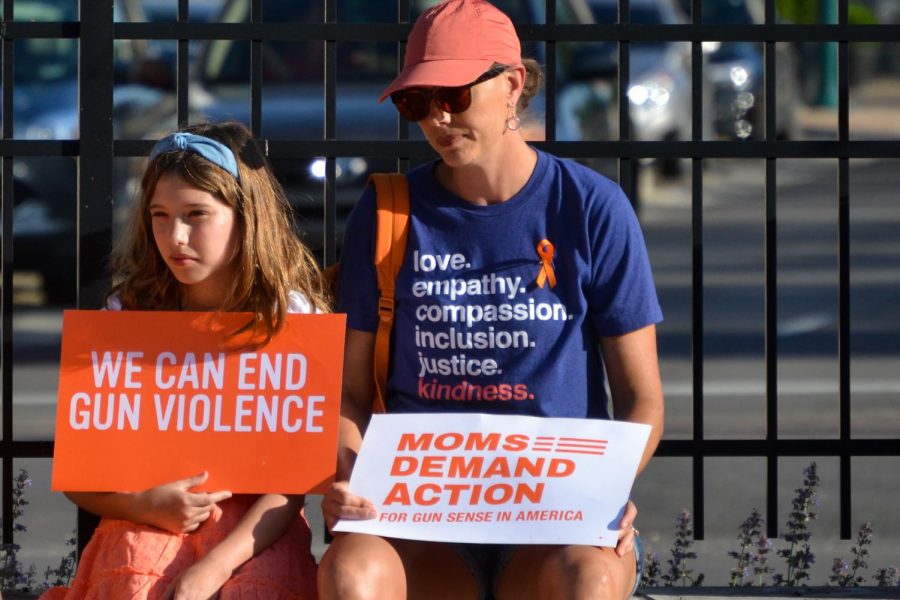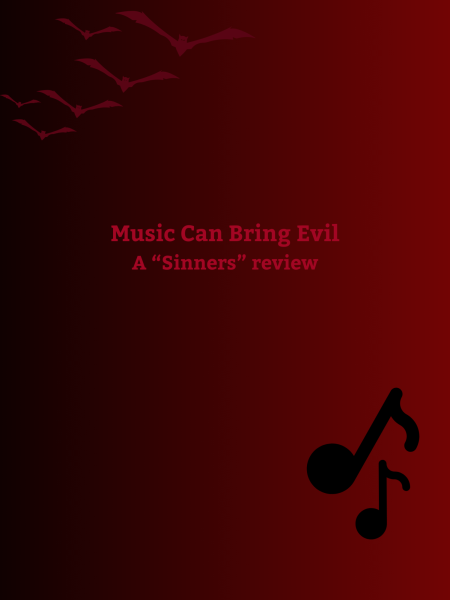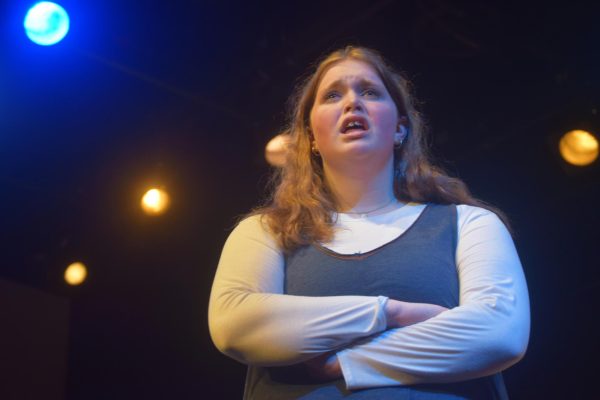Schools stricken by sorrowful shootings
A mother and daughter sit at gun control protest sponsored by Moms Demand Action in Fishers, Indiana on June 3, 2022.
Katrell Readus and Emerson Elledge are juniors and reporters for the Fishers Tiger Times. Their views do not necessarily reflect those of the newspaper.
School shooting massacres have become the norm for students currently enrolled in the American schooling system. As early as kindergarten, students around the county are instructed to complete drills to prepare for when an active shooter enters their supposed safe space. Crowded in tight classroom corners and closets, students sit knees pressed to chest, clutching textbooks and scissors, these average classroom items now serving a new purpose, weapons, though all this occurs only after the frantic rush to push desks and chairs against the classroom door, attempting to make sure that there is no chance of someone entering. The classrooms that were previously lively, with joyful youth, and the learning of anything and everything from the alphabet to algebra are now dark with the doors boarded and blocked as teachers whisper instructions for the children to remain in eerie silence.
This drill and other variations of it have become an expected routine in our society, one as standard as the required monthly fire drill or the annual hearing check. It is only when tragedy strikes, that it dawns on us as communities that the issue of active gun violence in schools has continued to occur on average over 87 times each year from 2013 to 2021, resulting in an annual average of 28.4 dead and 59.6 wounded, according to World Population Review.
The most recent of these school tragedies occurred on May 24 at Robb Elementary School in Uvalde, Texas. On this day, students were forced to endure the situation they had most likely been training for for years. A gunman was able to enter their building, in rage, ultimately killing 19 students and two teachers over the course of an hour. Within this hour, students had to take action to do what they could to ensure survival. Miah Cerrillo, age 11 told CNN that she covered herself with a friend’s blood to appear dead. Afterwards, the shooter moved to the adjacent room to continue the slaughter.
In that instance, this young girl acted in a way that has been taught to hundreds of thousands of students. She used what was at her disposal to protect herself and played dead.
As young children, many like the two of us, met our peers in our schools’ auditoriums or respective classrooms to prepare for the day that an armed assailant, as it was often referred to, walked our halls. It was explained to us in these moments that when the nightmare came true that the lights would be shut off quickly, with windows covered in a hushed hurry drowning us in darkness. It was then time for staff members to give us the task of arming ourselves with textbooks, scissors or anything else we could find as weapons in self defense, not to injure the assailant or even save our own lives, but to attempt to slow the gunman down, so even if we were killed, our classmates might have a chance for survival. We were also advised to play dead if escape was not an option. If the assailant were to find us, we were instructed to make our bodies as small as possible, so the assailant would have a lesser chance of shooting us whether it was an intended shot or stray bullet. Some of us giggled as we imagined ourselves playing the hero, taking down the bad guy with sharp aim or playing opossum as we called it, while not completely understanding the severity of an instance like the one these adults described. Now after hearing of a little girl not much older than we were at that time putting what we had giggled at into practice has brought about an opportunity for reflection.
Getting an education should never be a death sentence. Children are often told from a young age that school can and should serve as their home away from home, that the building should act as a place where our minds will be cultivated by the thought of the people we could become. Yet that chance to discover, imagine and grow can and as we have seen, very well might be ripped from us in a blink of an eye.
When the event we have been training for occurs, like the Sandy Hook Elementary shooting in 2012 or the Marjory Stoneman Douglas shooting in 2016, the second and fourth deadliest school shootings since 1999, respectively. The shooting at Robb Elementary is placed between these, making it third on this tragic list. These three shootings resulted in a combined total of 66 deaths of students and teachers. In response to this, politicians around the nation have made a statement of resounding silence by only giving their condolences and ordering flags to remain at half mast for a week or so. A large number of American citizens, near and far, offer nearly the same message by only contributing thoughts and prayers, thus leaving the deadly cycle to continue.
No other generation has been forced to carry a burden like this before. Throughout the 20th century, children were forced to enact drills in school, against bombs or other attacks, but these threats rarely, if ever, came to fruition.
We have been force-fed a concoction of media, describing the mental issues of these armed assailants. All this despite the fact that next to no measures are taken to benefit the mental health of children. The narrative given is that shootings are a massive devastation, but an anomaly. This pretense that guns are a necessity in our society to protect us from such incidents is flawed, this is proven by the police on the scene, the “good guys with guns,” were too cowardly and frightened to enter Robbs Elementary for 40 minutes, while children and adults were slaughtered.
We are expected to mourn, but not so much that it disrupts our regularly scheduled lives. We are expected to be outraged, but not so much that we desire actual change. We are expected to be brave in the face of danger, but not be frightened in simulations of the same danger.

Katrell is a senior at FHS. They are an overthinker who enjoys listening to music and writing poetry when they are not too focused on their upcoming article.

Emerson Elledge is a senior. She spends far too much time on her IB classes and wears too much jewelry. Her hobbies include studying philosophy, writing...












kai • Jul 23, 2022 at 3:32 pm
Great story, very thoughtout and detailed